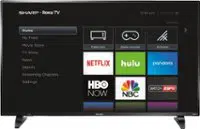Documents: Go to download!
- Owner's manual - (English)
- Installing the stands or wall-mount bracket
- TV components
- What connection should I use?
- Connecting a cable or satellite box
- Connecting an antenna or cable TV (no box)
- Connecting a DVD or Blu-ray player
- Connecting a game console
- Connecting a computer
- Connecting a USB flash drive
- Connecting headphones
- Connecting external speakers or a sound bar
- Connecting a home theater system with multiple devices
- Connecting power
- Setting up your TV
- Maintaining
- Troubleshooting
Table of contents
Owner Manual Televisions
Installing the stands or wall-mount bracket
- If you want to place your TV on a table or in an entertainment center, go to Installing the stands.
- If you want to mount your TV on a wall, go to Installing a wall-mount bracket.
Notes
- If you plan to wall-mount your TV, do not install the stands.
- Store the stands and stand screws in case you decide to use the stands in the future.
Installing the stands
- Carefully place your TV face-down on a cushioned, clean surface to protect the screen.
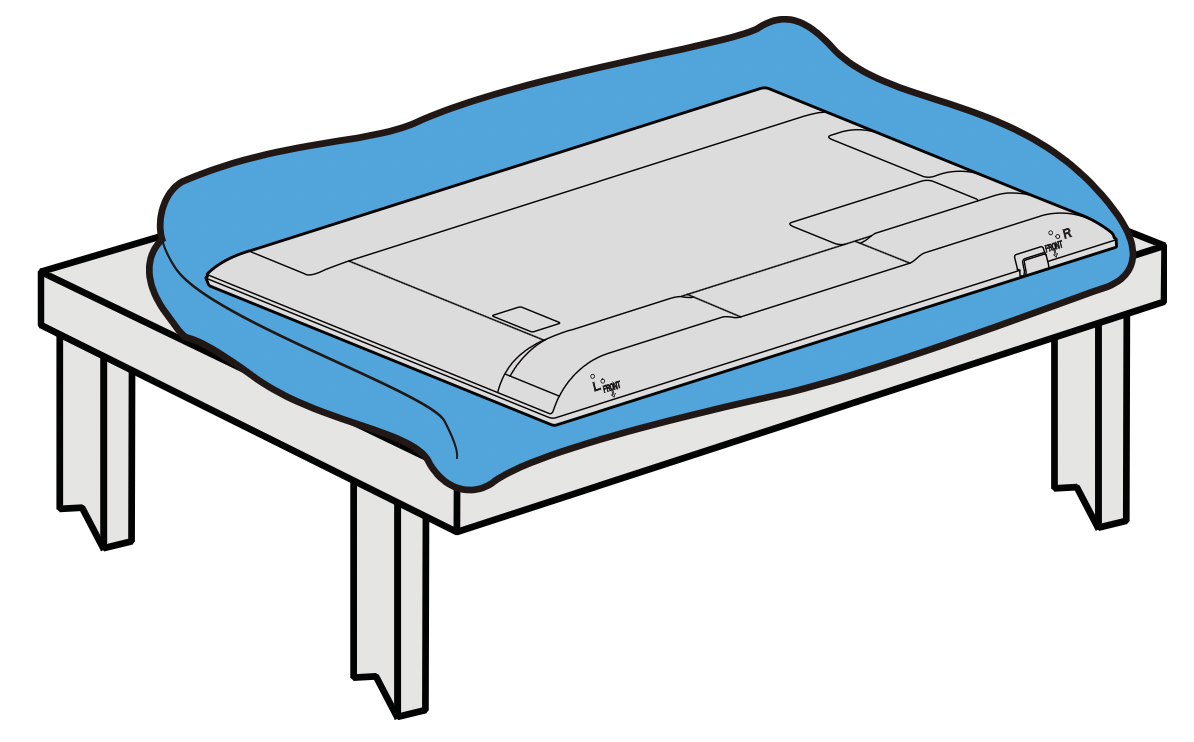
- Align the TV stands with the screw holes on the bottom of the TV. Make sure that the arrows on the stands are pointing towards the front of the TV. Secure the stands to the TV with the four provided screws.
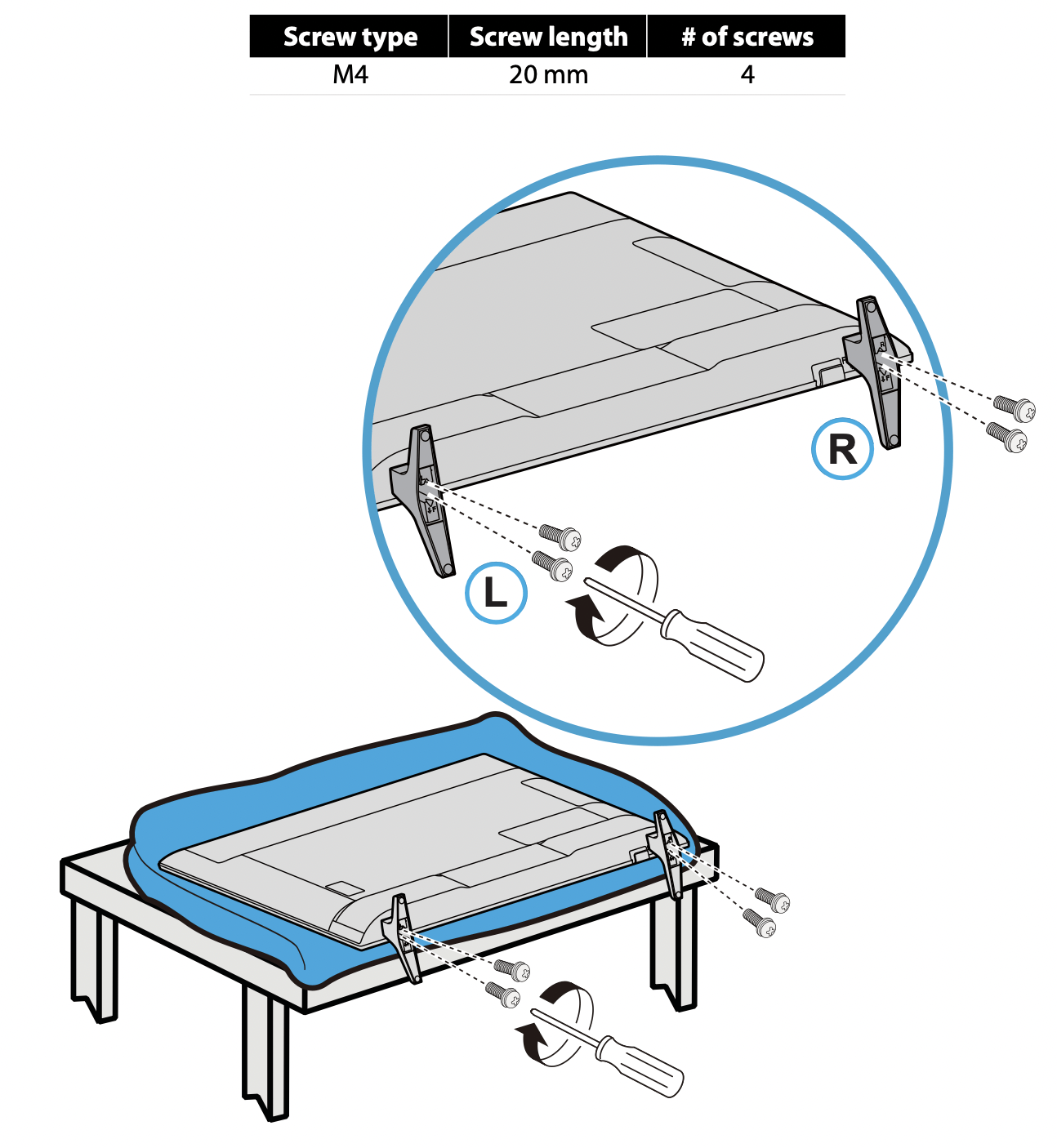
Installing a wall-mount bracket
Warnings
- Your TV has four VESA mounting holes on the back. If you attach a wall-mount bracket to the back of your TV, the bracket must be securely attached, using all four holes. If you do not use all four mounting holes, your TV may fall and cause property damage or personal injury. See the documentation that came with your wall mount for complete mounting instructions.
- Your TV is intended to be supported by a UL Listed wall mount bracket with suitable weight/load. (See Miscellaneous on page 44.)
- Carefully place your TV face-down on a cushioned, clean surface to protect the screen.
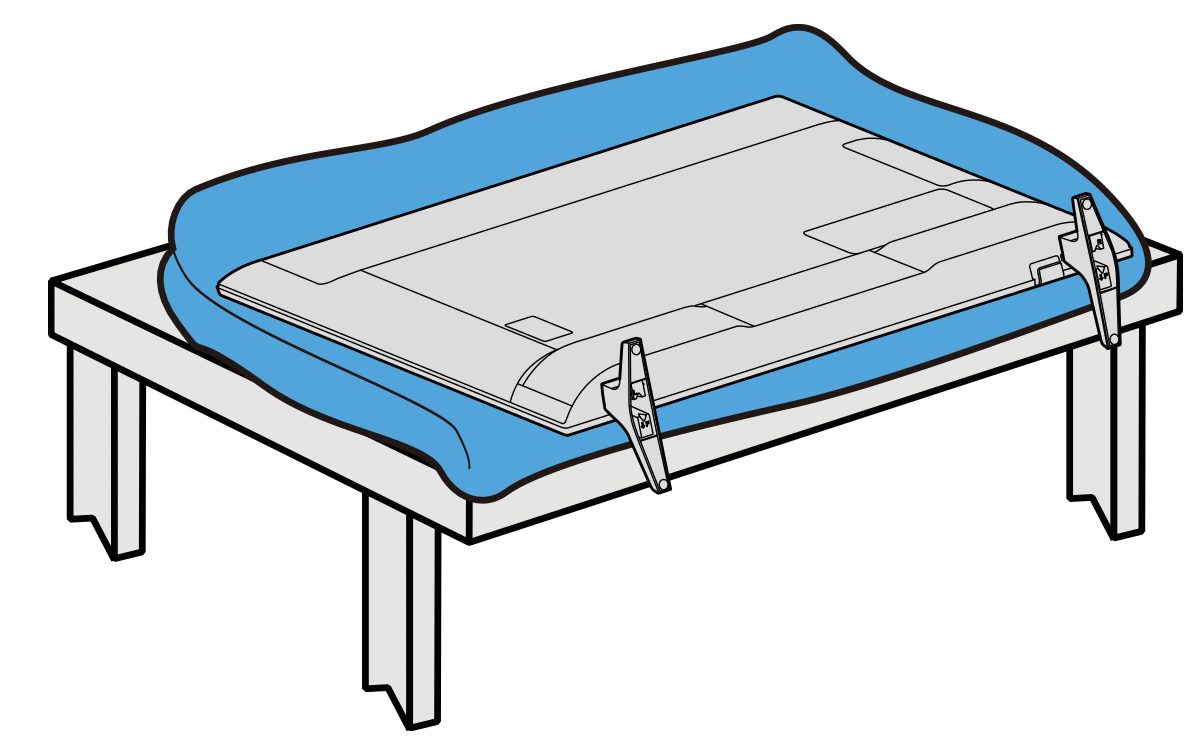
- If the TV stands are installed, remove the four screws that secure the stands to your TV.

- Attach the wall-mount bracket to your TV using the mounting holes on the back of your TV. See the instructions that came with the wall-mount bracket for information about how to correctly hang your TV.
Notes:
See other models: 40Q5000U LC-32Q3170U LC-43Q3000U LC-40LB480U LC-65Q620U
The length of the wall-mount screws vary depending on the wall-mount bracket you purchased. See the instructions that came with the wall-mount bracket for screw lengths.
The mounting holes on the back of your TV take type M6 screws (14 mm).
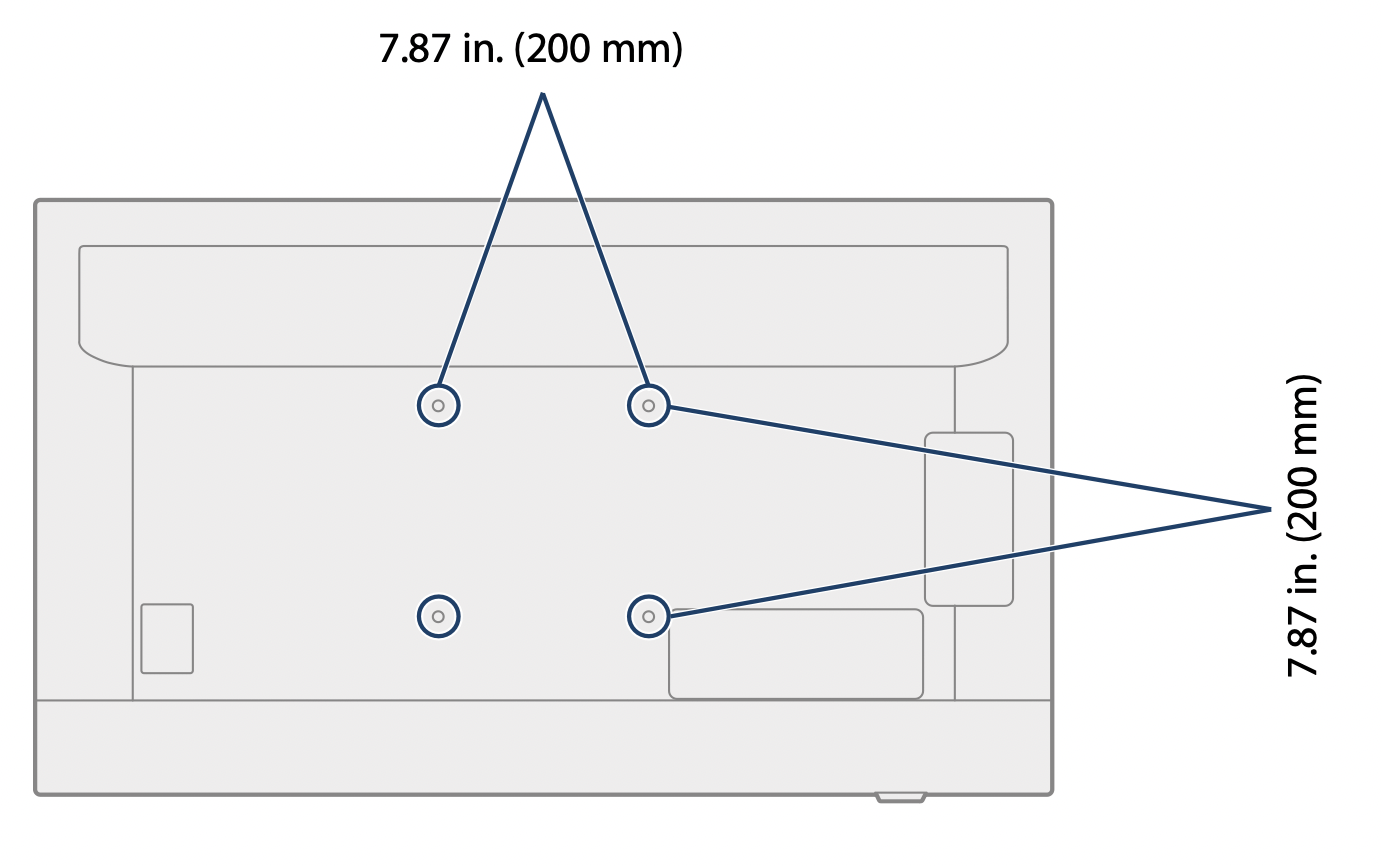
TV components
Your TV has built-in controls for adjusting basic settings and several sets of jacks for connecting devices to your TV.
This section contains information about:
- Package contents
- Front features
- Side jacks
- Back jacks
- Remote control
Package contents
- 43" or 50" LED Sharp Roku TV
- Remote control and batteries (2 AAA)
- TV stands (2)
- Screws (4)
- Power cord
- Quick Setup Guide
- Important Information
- Roku TV End User License Agreement (EULA)
Front features
Besides the viewing screen, the front has a remote control sensor, to receive the signals from the remote control (do not block), and a status indicator.
The status indicator lights red when your TV is off, turns off when your TV is on, or blinks when receiving commands from the remote control.
Side jacks
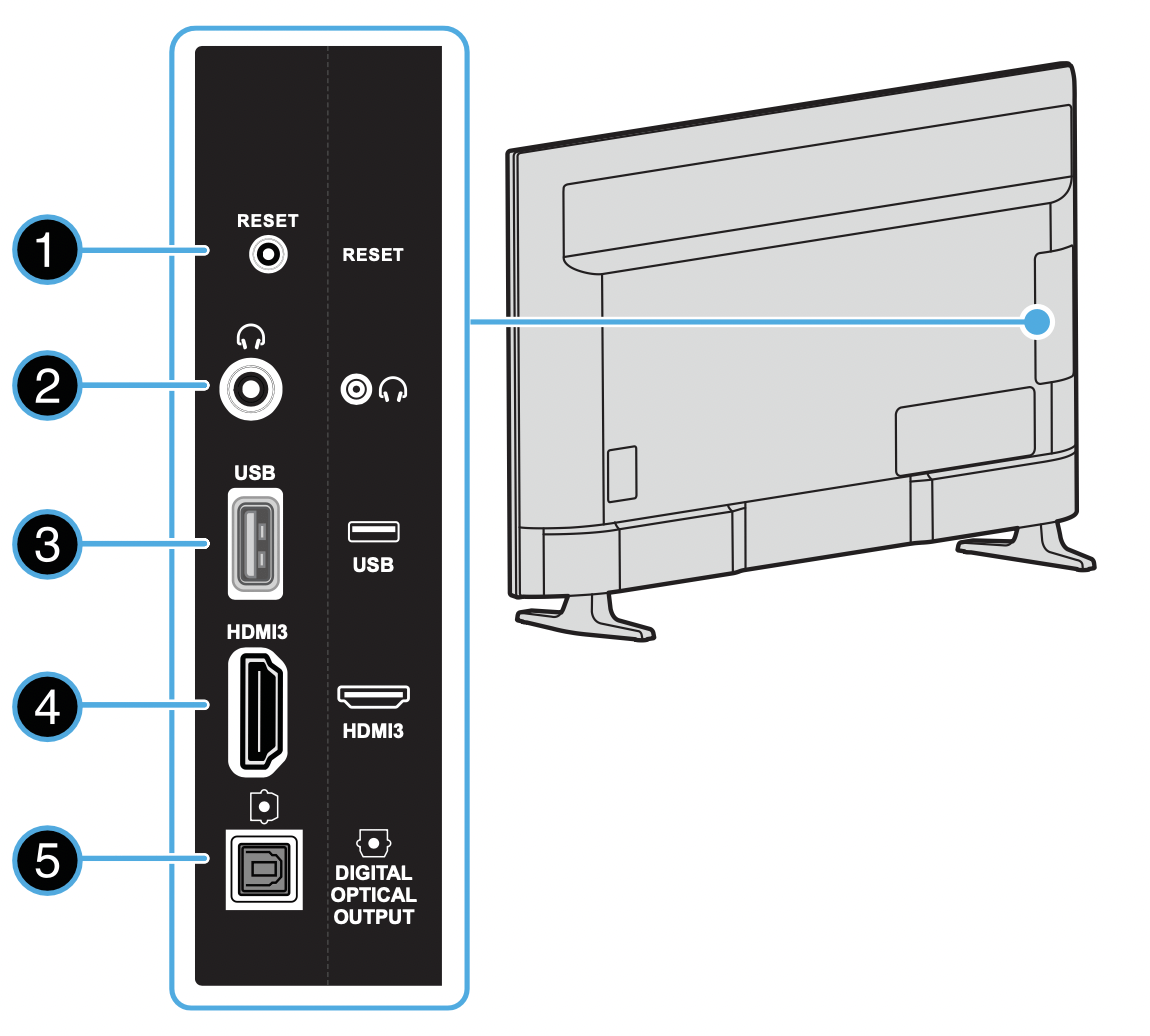
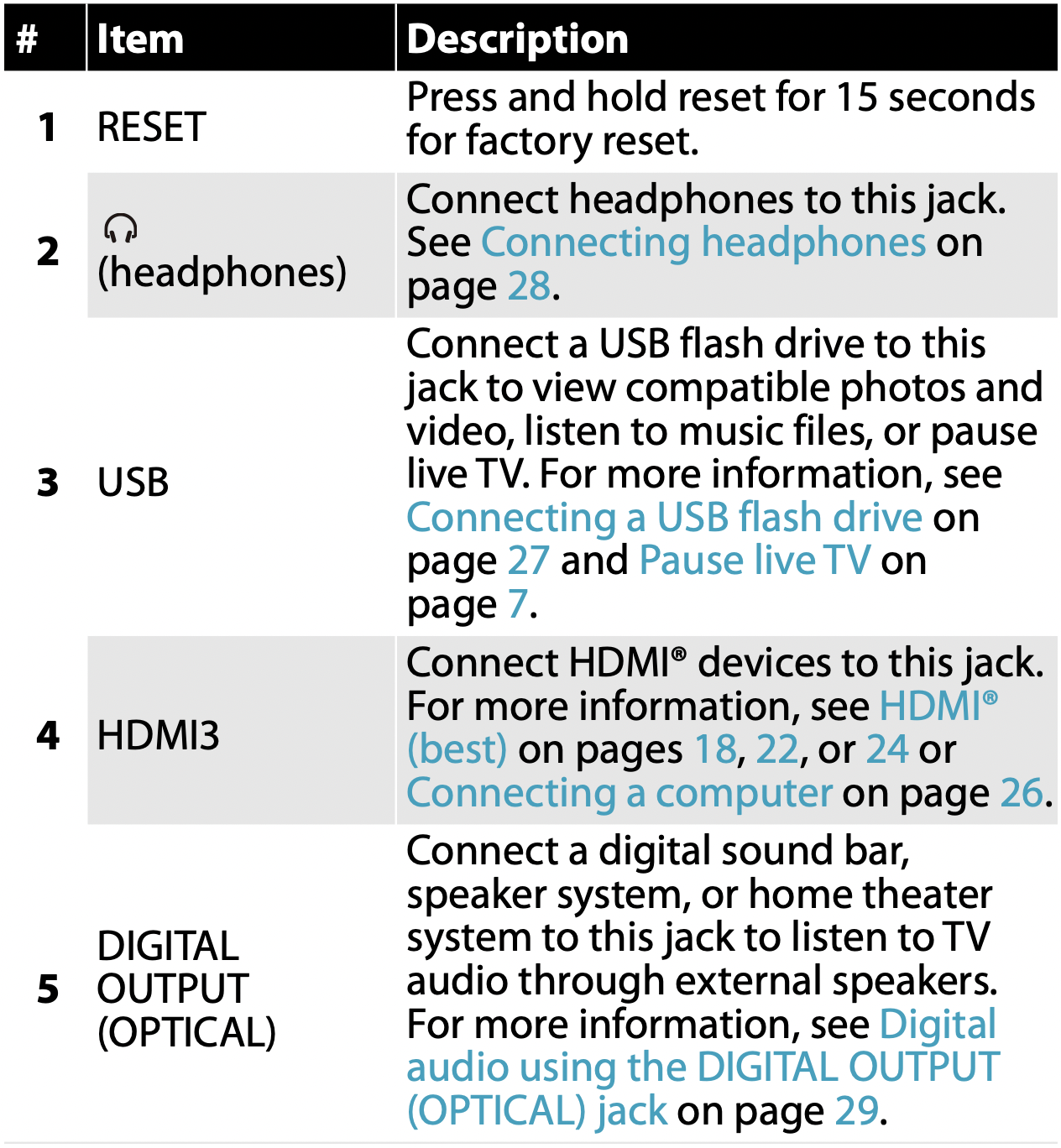
Back jacks
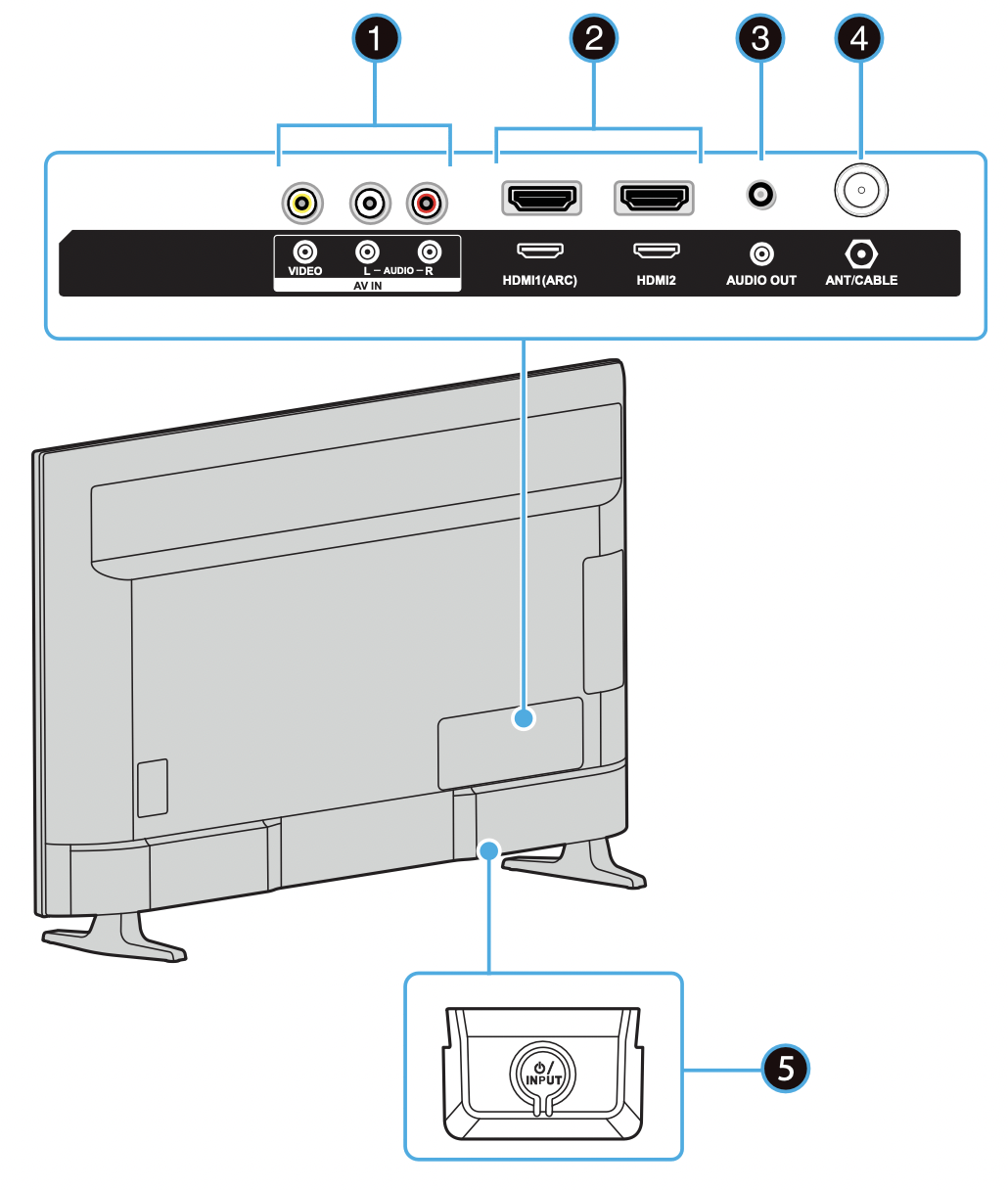

Remote control

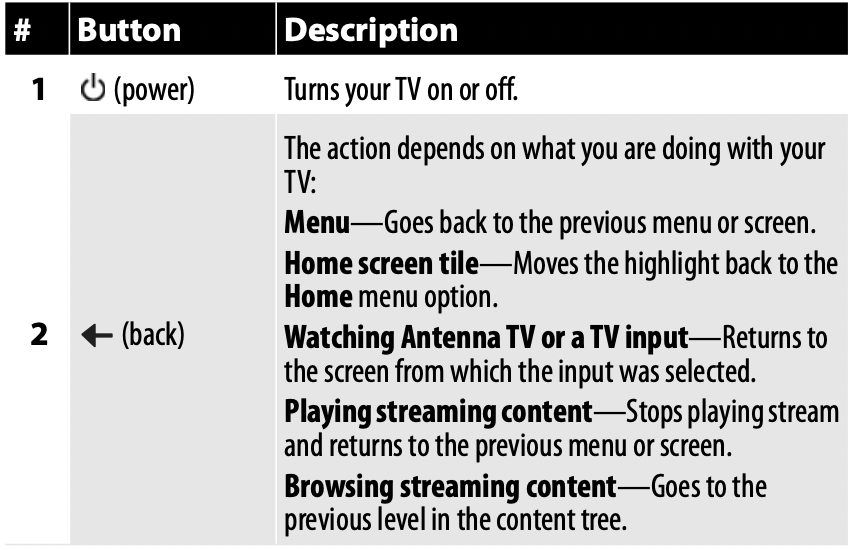

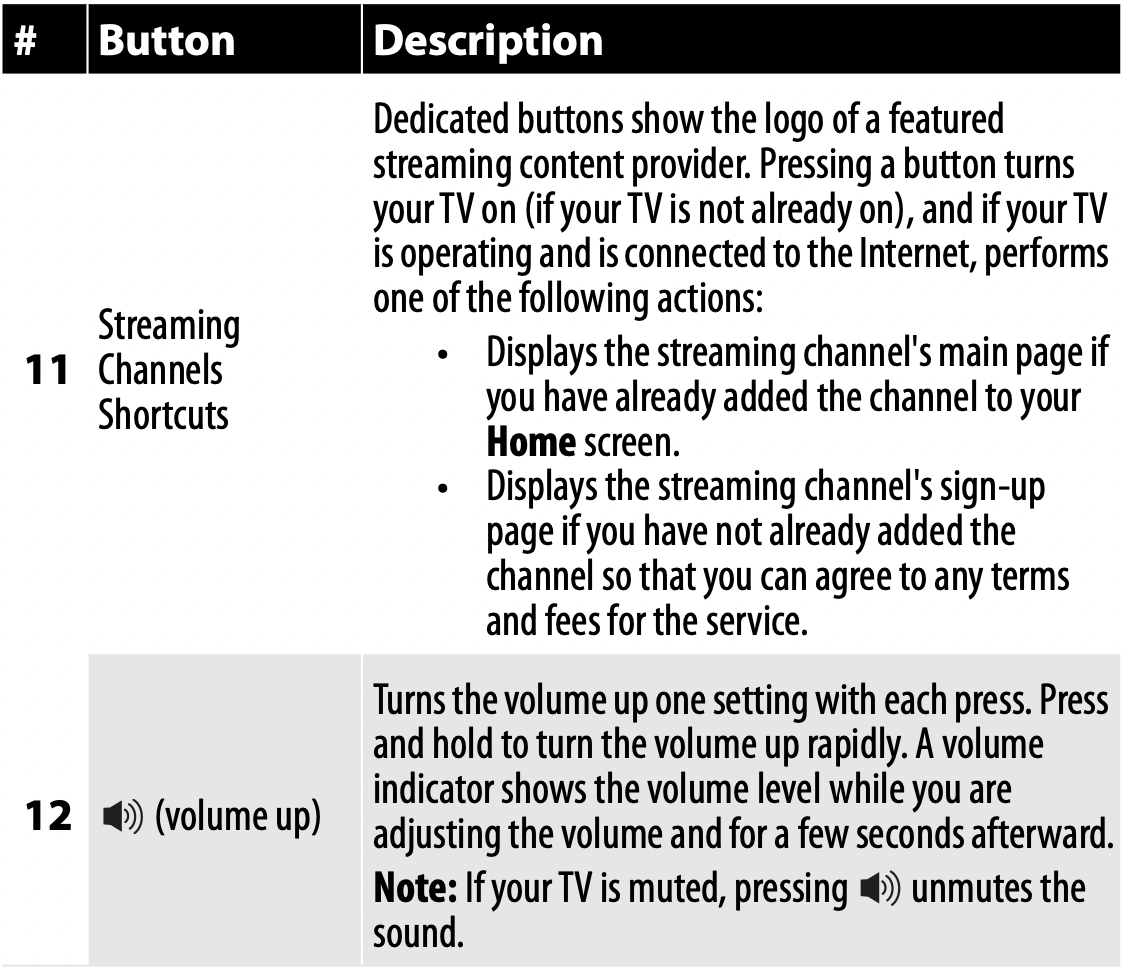
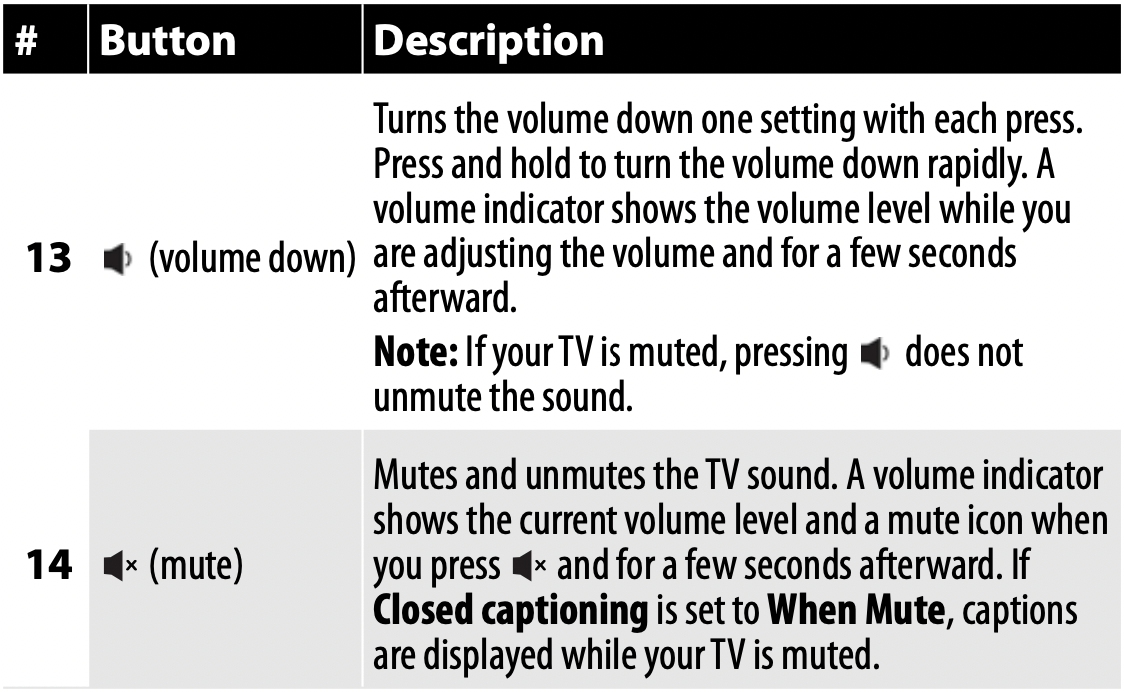
What connection should I use?
Your TV has several connection types for connecting devices to your TV.
For the best video quality, you should connect a device to the best available connection.
Use the following tables to identify cables:

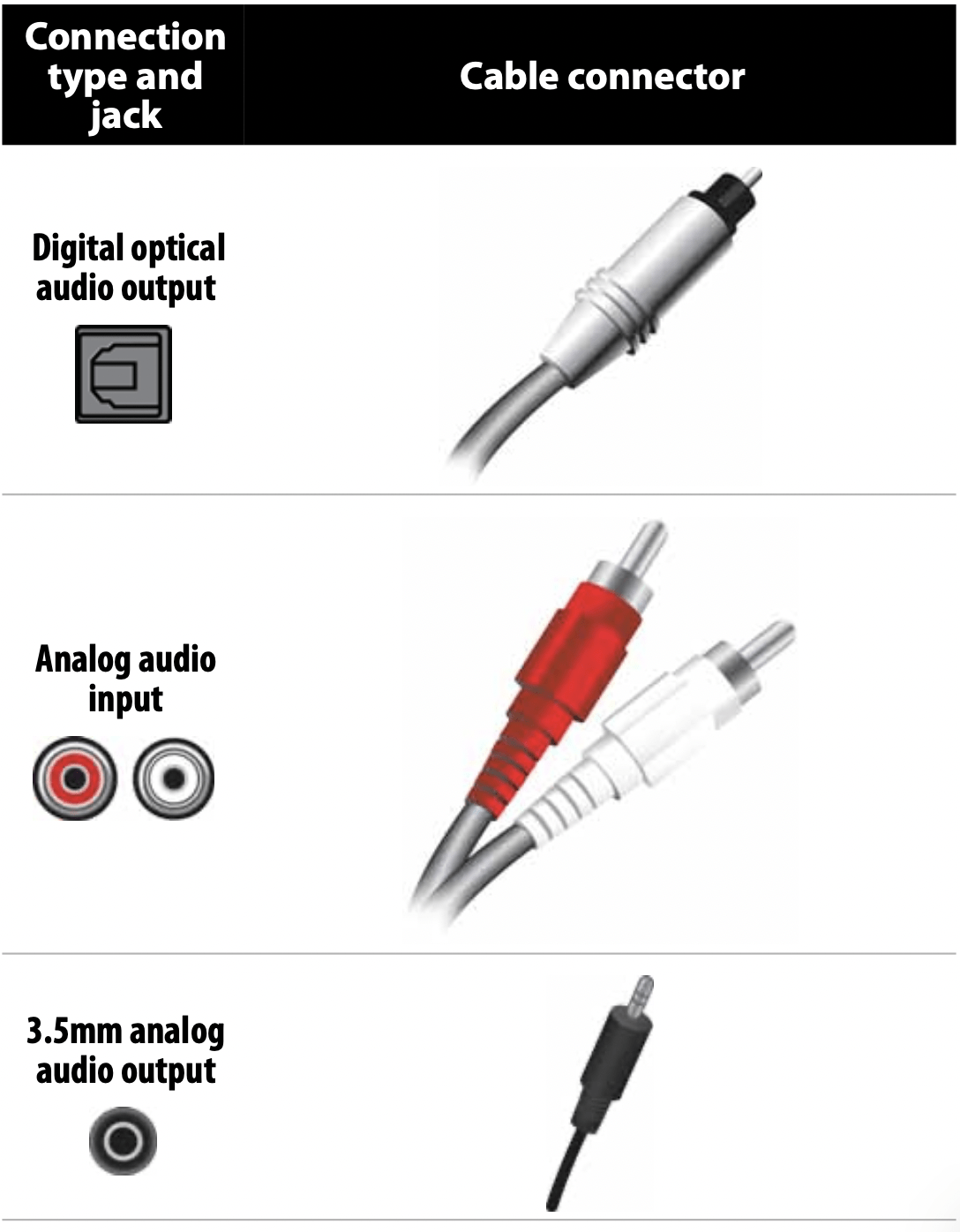
Cautions
- Check the jacks for position and type before making any connections.
- Loose connections can cause poor audio or video quality. Make sure that all connections are tight and secure.
- The external audio/video devices shown may be different from your devices. If you have questions, refer to the documentation that came with your devices.
- Always turn off your TV when connecting external devices.
Connecting a cable or satellite box
Many cable or satellite TV boxes have more than one connection type. To get the best video, you should use the best connection type available. For more information, see What connection should I use? on page 17.
You can connect your cable or satellite box using:
- HDMI® (best)
- AV (good)
- Coaxial (good)
HDMI® (best)
Note: For better picture quality, we recommend that you use cables designated as High Speed HDMI® cables.
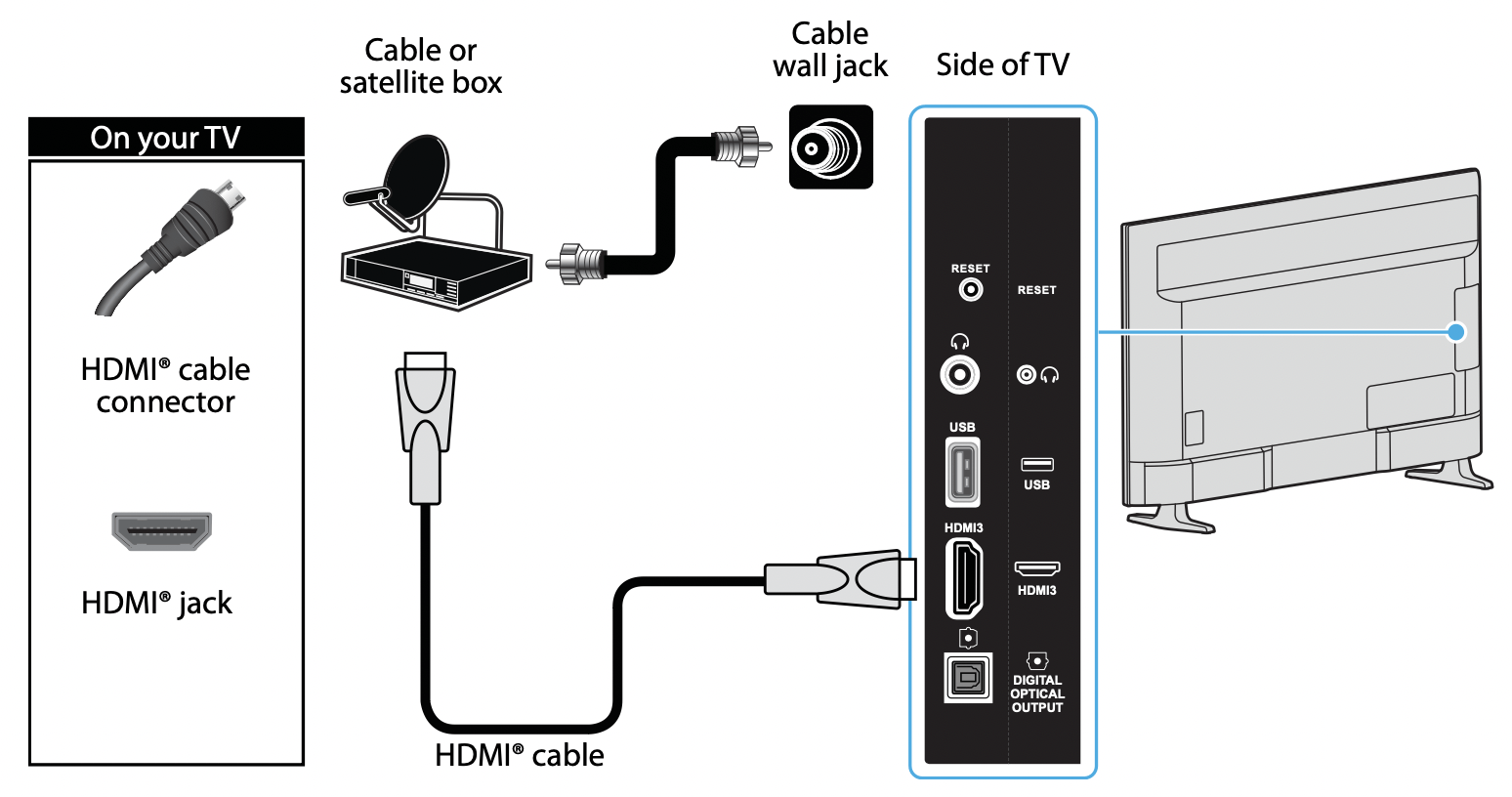
- Make sure that your TV’s power cord is unplugged and all connected devices are turned off.
- Connect the incoming cable from the cable wall jack to the cable-in jack on the cable or satellite box.
- Connect an HDMI® cable (not provided) to an HDMI jack on side or back of your TV and to the HDMI OUT jack on the cable or satellite box.
- Plug your TV’s power cord into a power outlet, turn on your TV, then turn on the cable or satellite box.
- On the Home screen, press
 or
or  to highlight the HDMI 1, HDMI 2, or HDMI 3 tile, then press OK.
to highlight the HDMI 1, HDMI 2, or HDMI 3 tile, then press OK.
Note: An HDMI® cable carries both audio and video. You do not need to use any audio cables.
AV (good)
Notes: Cables are often color-coded to match color-coded jacks.
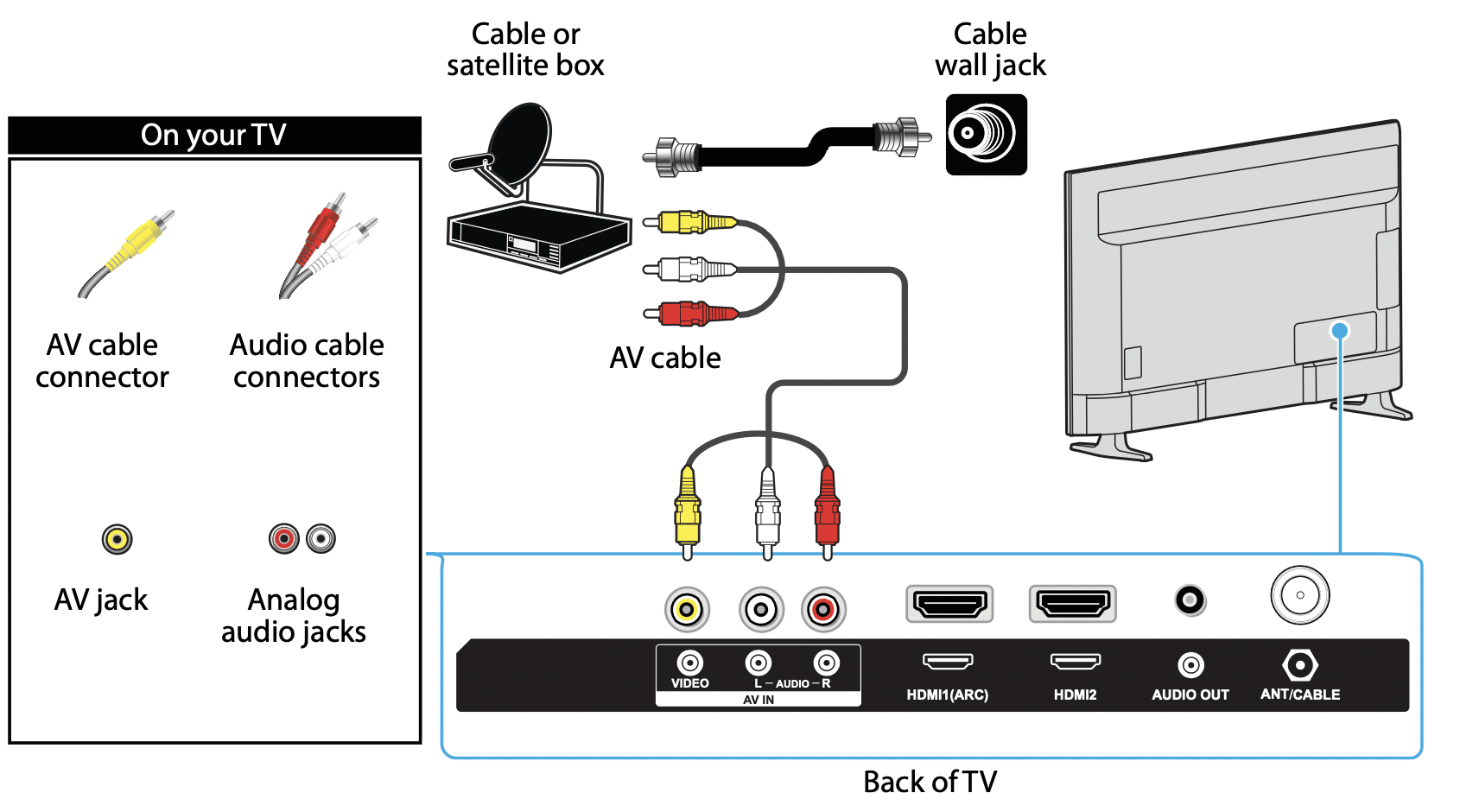
- Make sure that your TV’s power cord is unplugged and all connected devices are turned off.
- Connect the incoming cable from the cable wall jack to the cable-in jack on the cable or satellite box.
- Connect an AV cable (not provided) to the VIDEO jack and L and R AUDIO jacks on the back of your TV and to the AV and audio out jacks on the cable or satellite box.
Note: When you connect the audio using the L and R AUDIO jacks, the audio output is analog. - Plug your TV’s power cord into a power outlet, turn on your TV, then turn on the cable or satellite box.
- On the Home screen, press
 or
or  to highlight the AV tile, then press OK.
to highlight the AV tile, then press OK.
Coaxial (good)
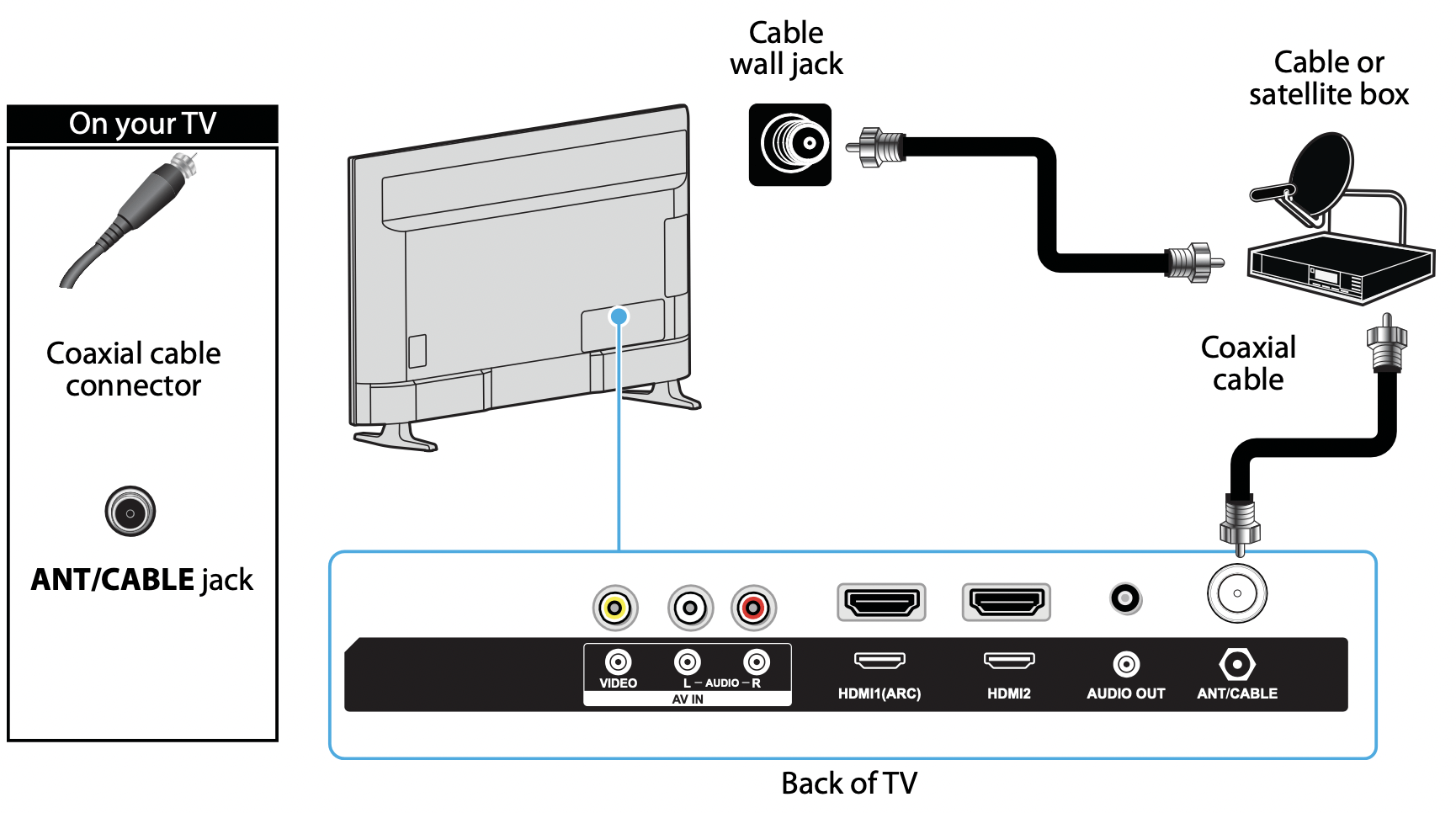
- Make sure that your TV’s power cord is unplugged and all connected devices are turned off.
- Connect the incoming cable from the cable wall jack to the cable-in jack on the cable or satellite box.
- Connect a coaxial cable (not provided) to the ANT/CABLE jack on the back of your TV and to the coaxial out jack on the cable or satellite box.
- Plug your TV’s power cord into a power outlet, turn on your TV, then turn on the cable or satellite box.
- On the Home screen, press
 or
or  to highlight the Antenna TV tile, then press OK. If you have not set up the TV tuner, follow the on-screeen instructions.
to highlight the Antenna TV tile, then press OK. If you have not set up the TV tuner, follow the on-screeen instructions.
Notes
- Use a coaxial cable to eliminate interference and noise from radio waves.
- Do not bundle the coaxial cable with the power cord or other cables.
Connecting an antenna or cable TV (no box)
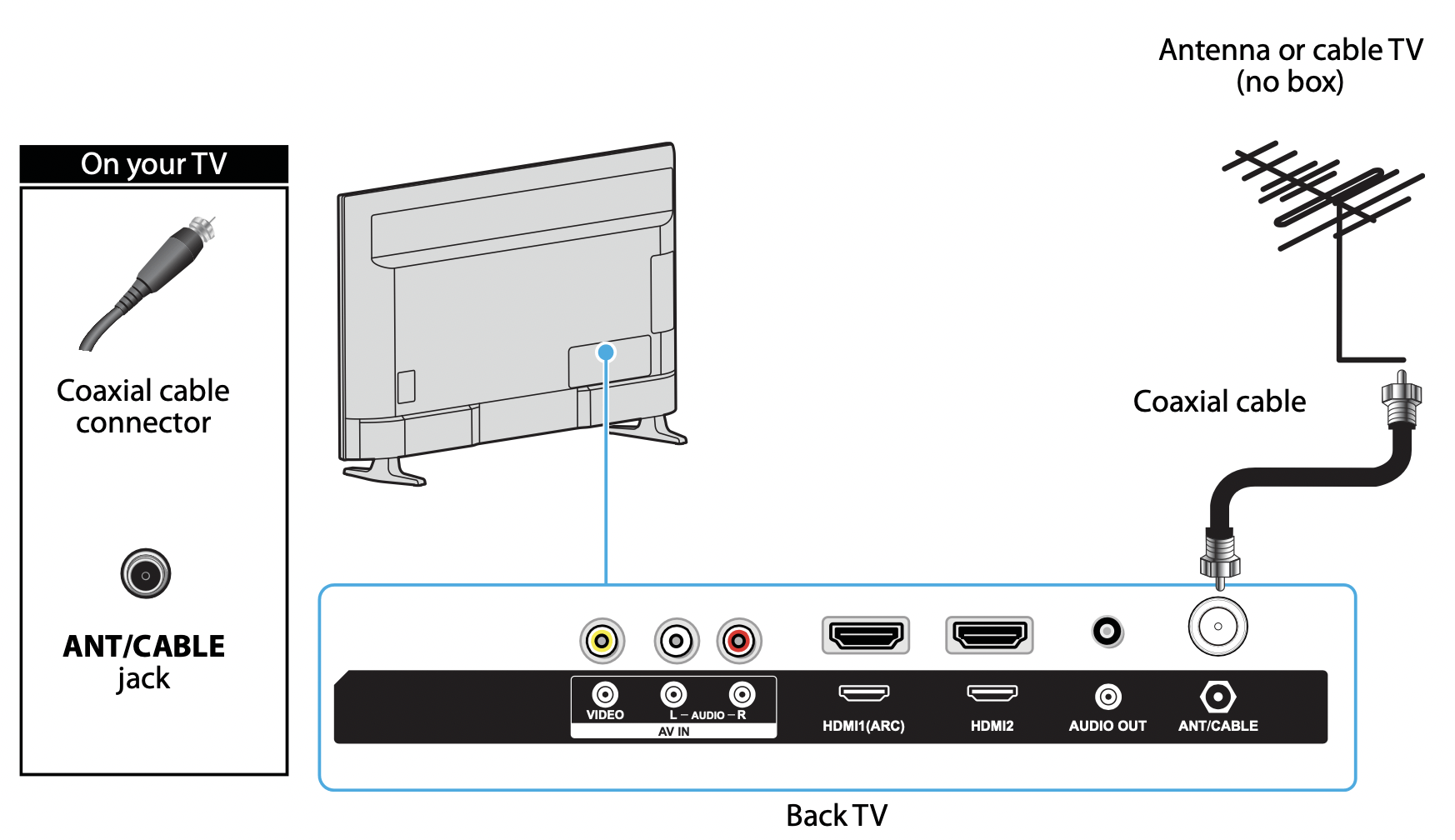
- Make sure that your TV’s power cord is unplugged and all connected devices are turned off.
- Connect a coaxial cable (not provided) to the ANT/CABLE IN jack on the back of your TV and to the antenna or cable TV wall jack.
- Plug your TV’s power cord into a power outlet, then turn on your TV.
- On the Home screen, press
 or
or  to highlight the Antenna TV tile, then press OK. If you have not set up the TV tuner, follow the on-screeen instructions.
to highlight the Antenna TV tile, then press OK. If you have not set up the TV tuner, follow the on-screeen instructions.
Notes
- Use a coaxial cable to eliminate interference and noise from radio waves.
- Do not bundle the coaxial cable with the power cord or other cables.
- If the antenna is not installed correctly, contact qualified service personnel to correct the problem.
- If the signal level for a channel is weak, the picture may be distorted. Adjust the antenna or use a highly directional outdoor or set-top antenna with a built-in amplifier.
- If the picture quality is good on some channels and poor on others, the problem may be caused by a poor or weak signal from the broadcaster or cable TV provider.
- If you connect to cable TV without a set-top box and experience poor picture quality, you may need to install a set-top box to improve signal reception and picture quality. Contact your cable TV provider about upgrading to a set-top box.
- Many high-definition (HD) channels upscale standard-definition (SD) content. The picture displayed on your TV is still displayed as SD, thus the picture quality will not be as clear or crisp as it would be if the content was originally recorded in HD.
Connecting a DVD or Blu-ray player
Many DVD or Blu-ray players have more than one connection type. To get the best video, you should use the best connection type available. For more information, see What connection should I use? on page 17.
You can connect a DVD or Blu-ray player using:
- HDMI® (best)
- AV (good)
HDMI® (best)
Note: For better picture quality, we recommend that you use cables designated as High Speed HDMI® cables.

- Make sure that your TV’s power cord is unplugged and the DVD or Blu-ray player is turned off.
- Connect an HDMI® cable (not provided) to an HDMI jack on the side or back of your TV and to the HDMI OUT jack on the DVD or Blu-ray player.
- Plug your TV’s power cord into a power outlet, then turn on your TV and DVD or Blu-ray player.
- On the Home screen, press
 or
or  to highlight the HDMI 1, HDMI 2, or HDMI 3 tile, then press OK.
to highlight the HDMI 1, HDMI 2, or HDMI 3 tile, then press OK.
Note: An HDMI® cable carries both audio and video. You do not need to use any audio cables.
AV (good)
Note: Cables are often color-coded to match color-coded jacks.
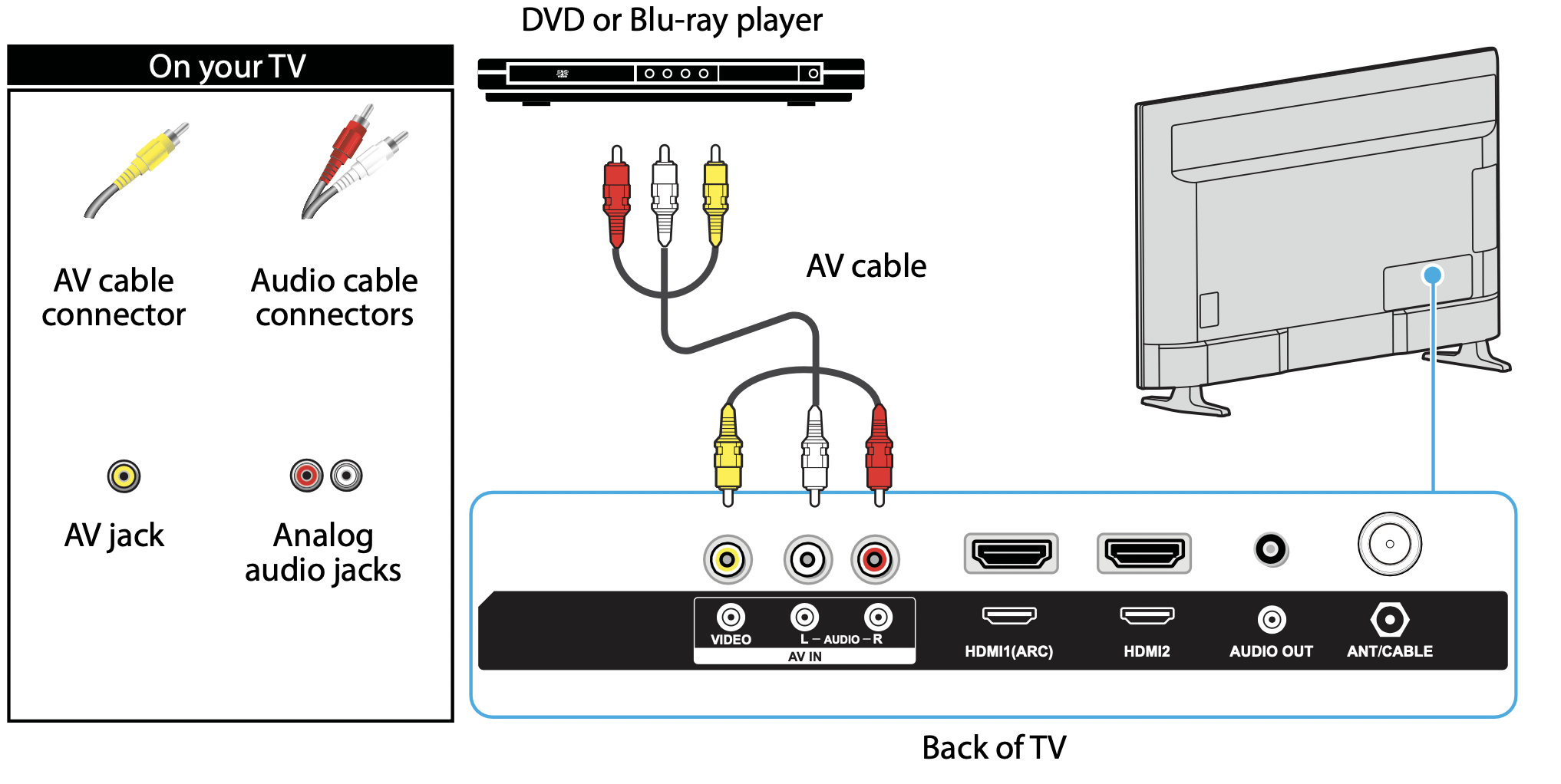
- Make sure that your TV’s power cord is unplugged and the DVD or Blu-ray player is turned off.
- Connect an AV cable (not provided) to the VIDEO jack and L and R AUDIO jacks on the back your TV and to the AV OUT jacks on the DVD or Blu-ray player.
Note: When you connect the audio using the L and R AUDIO jacks, the audio output is analog. - Plug your TV’s power cord into a power outlet, then turn on your TV and DVD or Blu-ray player. 4 On the Home screen, press
 or
or  to highlight the AV tile, then press OK.
to highlight the AV tile, then press OK.
Connecting a game console
Many game consoles have more than one connection type. To get the best video, you should use the best connection type available. For more information, see What connection should I use? on page 17.
You can connect a game console using:
- HDMI® (best)
- AV (good)
HDMI® (best)
Note: For better picture quality, we recommend that you use cables designated as High Speed HDMI® cables.
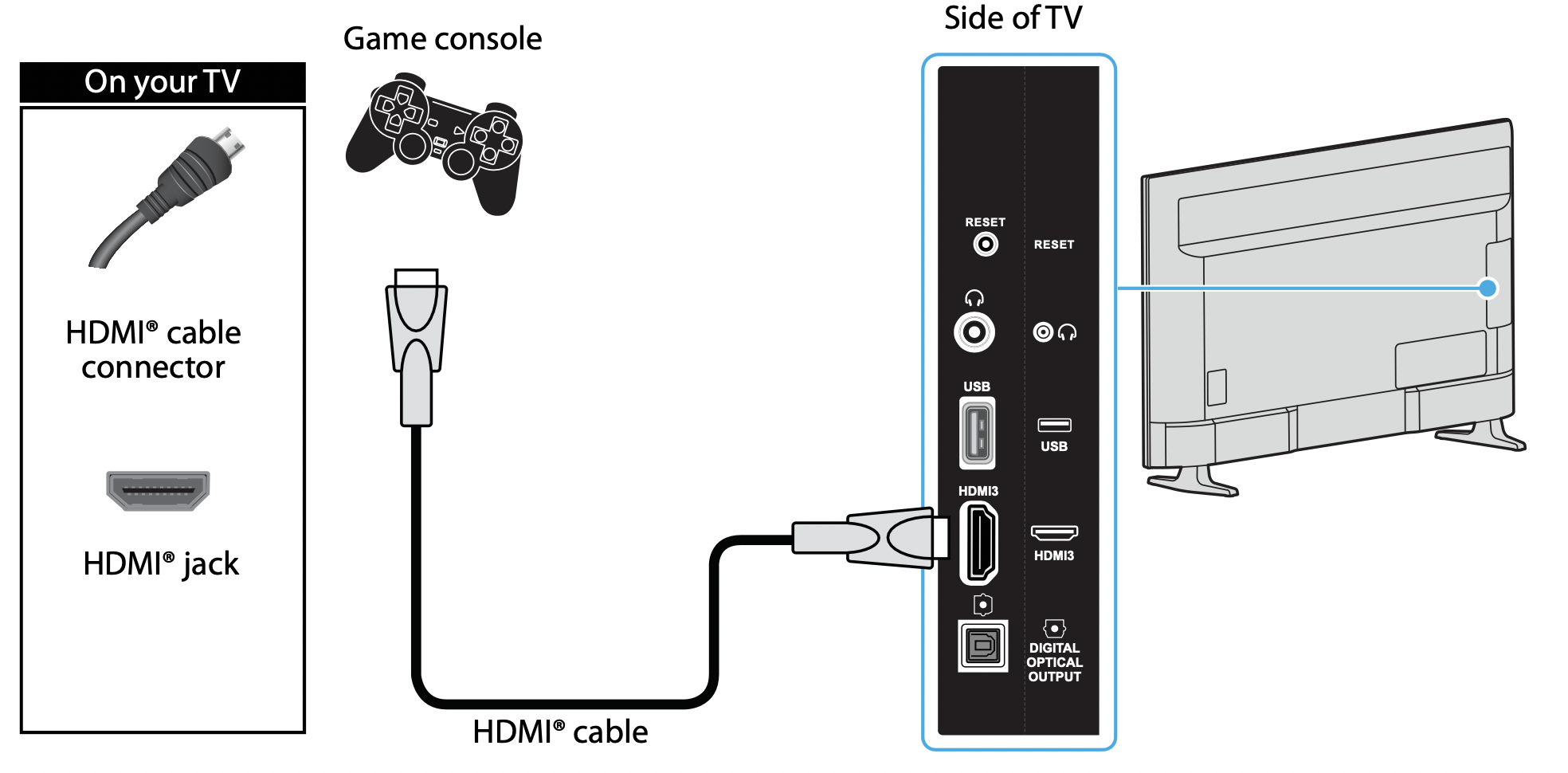
- Make sure that your TV’s power cord is unplugged and the game console is turned off.
- Connect an HDMI® cable (not provided) to an HDMI jack on the side or back of your TV and to the HDMI OUT jack on the game console.
- Plug your TV’s power cord into a power outlet, then turn on your TV and the game console.
- On the Home screen, press
 or
or  to highlight the HDMI 1, HDMI 2, or HDMI 3 tile, then press OK.
to highlight the HDMI 1, HDMI 2, or HDMI 3 tile, then press OK.
Note: An HDMI® cable carries both audio and video. You do not need to use any audio cables.
AV (good)
Note: Cables are often color-coded to match color-coded jacks.
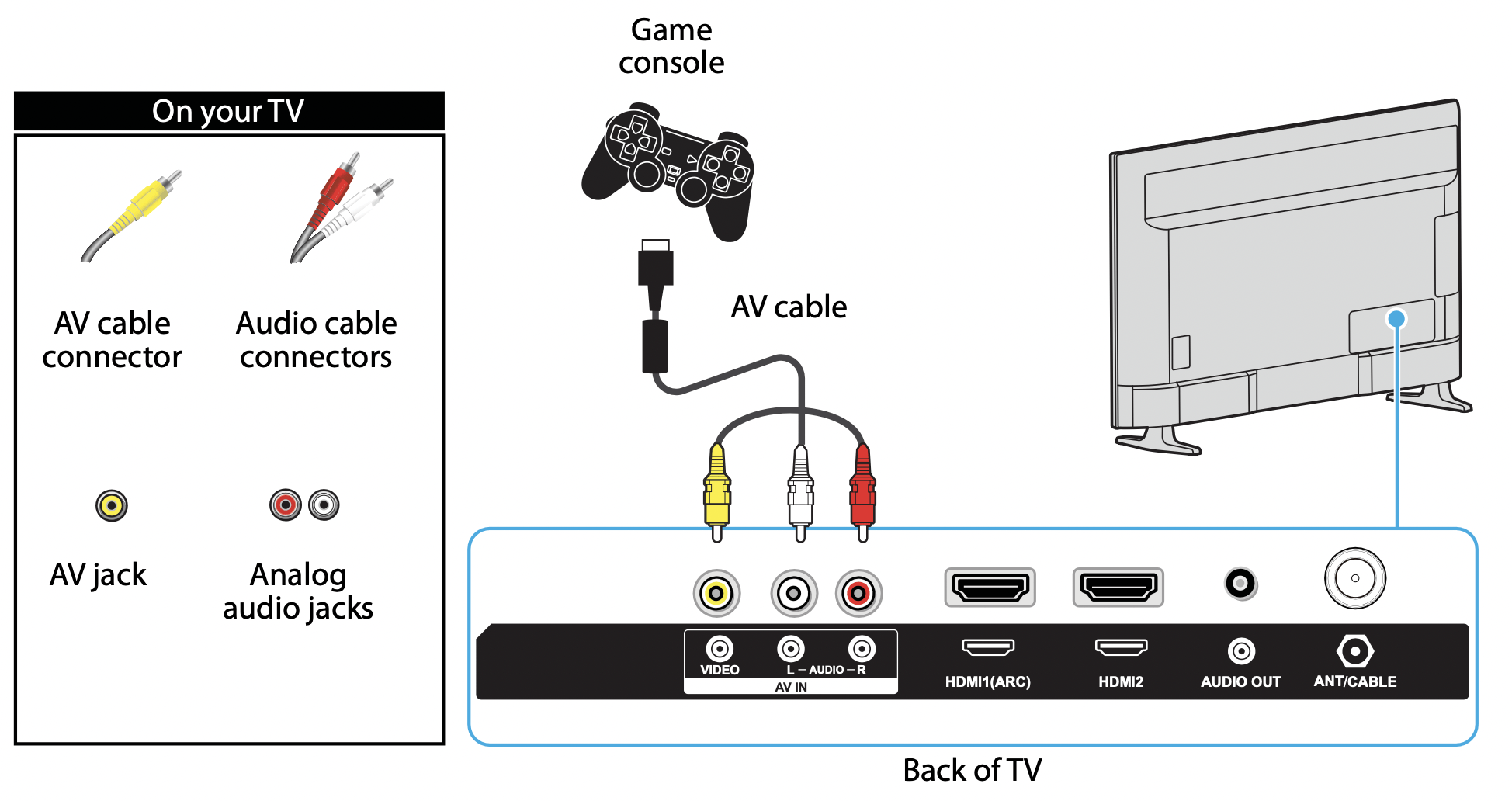
- Make sure that your TV’s power cord is unplugged and the game console is turned off.
- Connect the game console’s AV cable (not provided) to the VIDEO jack and L and R AUDIO jacks on the back of your TV and to the AV jack(s) on the game console.
Note:
Some older game consoles come with a special AV cable. See the documentation that came with your game console or check the manufacturer’s website.
When you connect the audio using the L and R AUDIO jacks, the audio output is analog. - Plug your TV’s power cord into a power outlet, then turn on your TV and the game console.
- On the Home screen, press
 or
or  to highlight the AV tile, then press OK.
to highlight the AV tile, then press OK.
Connecting a computer
You can use an HDMI® jack on your TV to connect to a computer.
Note: For better picture quality, we recommend that you use cables designated as High Speed HDMI® cables.
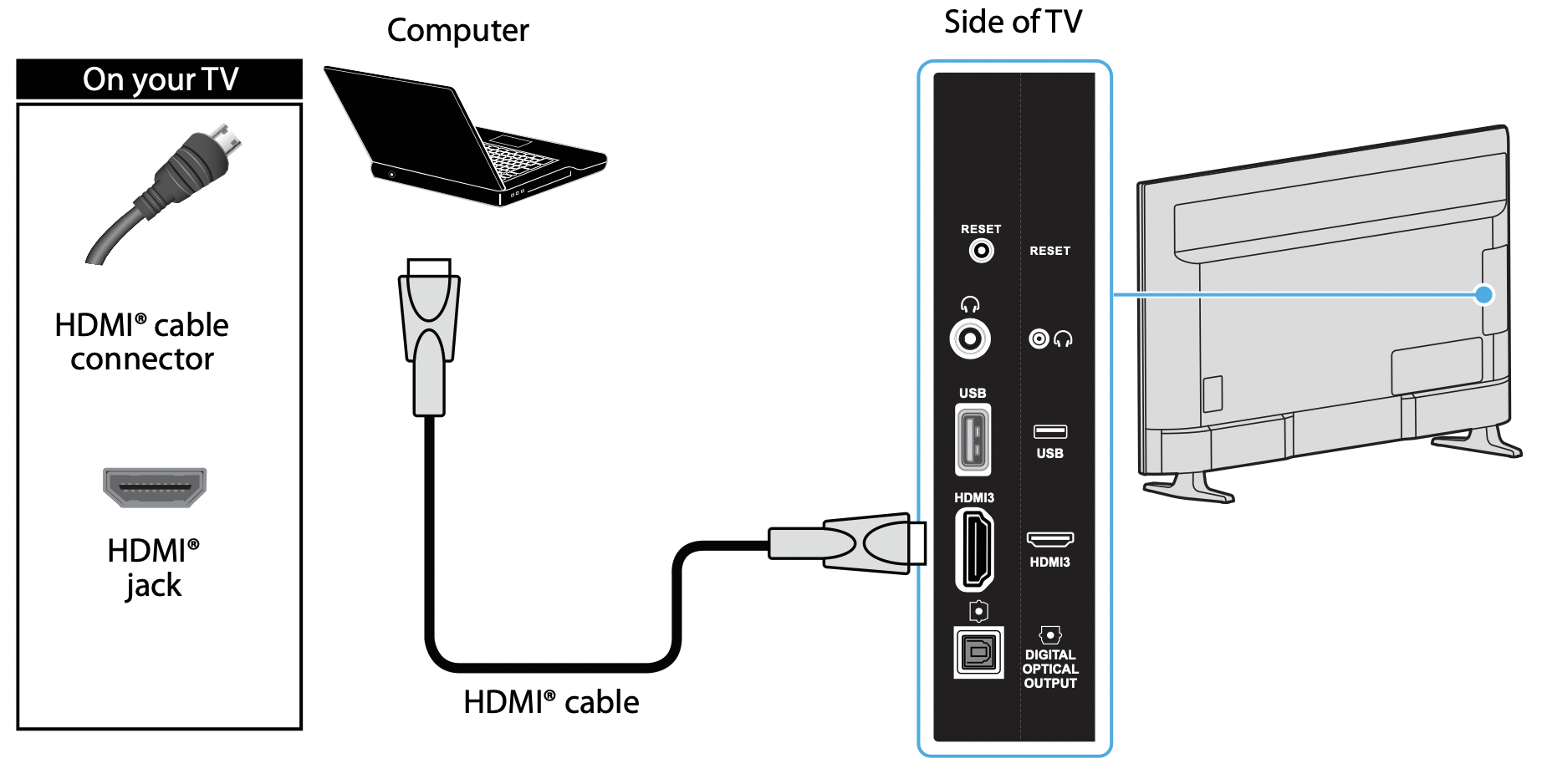
- Make sure that your TV’s power cord is unplugged and the computer is turned off.
- Connect an HDMI® cable (not provided) to an HDMI jack on the side or back of your TV and to the HDMI OUT jack on the computer.
- Plug your TV’s power cord into a power outlet, then turn on your TV and the computer.
- On the Home screen, press
 or
or  to highlight the HDMI 1, HDMI 2, or HDMI 3 tile, then press OK.
to highlight the HDMI 1, HDMI 2, or HDMI 3 tile, then press OK. - Adjust the display properties on the computer, if necessary.
Connecting a USB flash drive
When you connect a USB flash drive to the USB jack on your TV, you can view photos and videos or listen to music stored on the drive or you can use the Live TV Pause feature to pause live TV for up to 90 minutes.
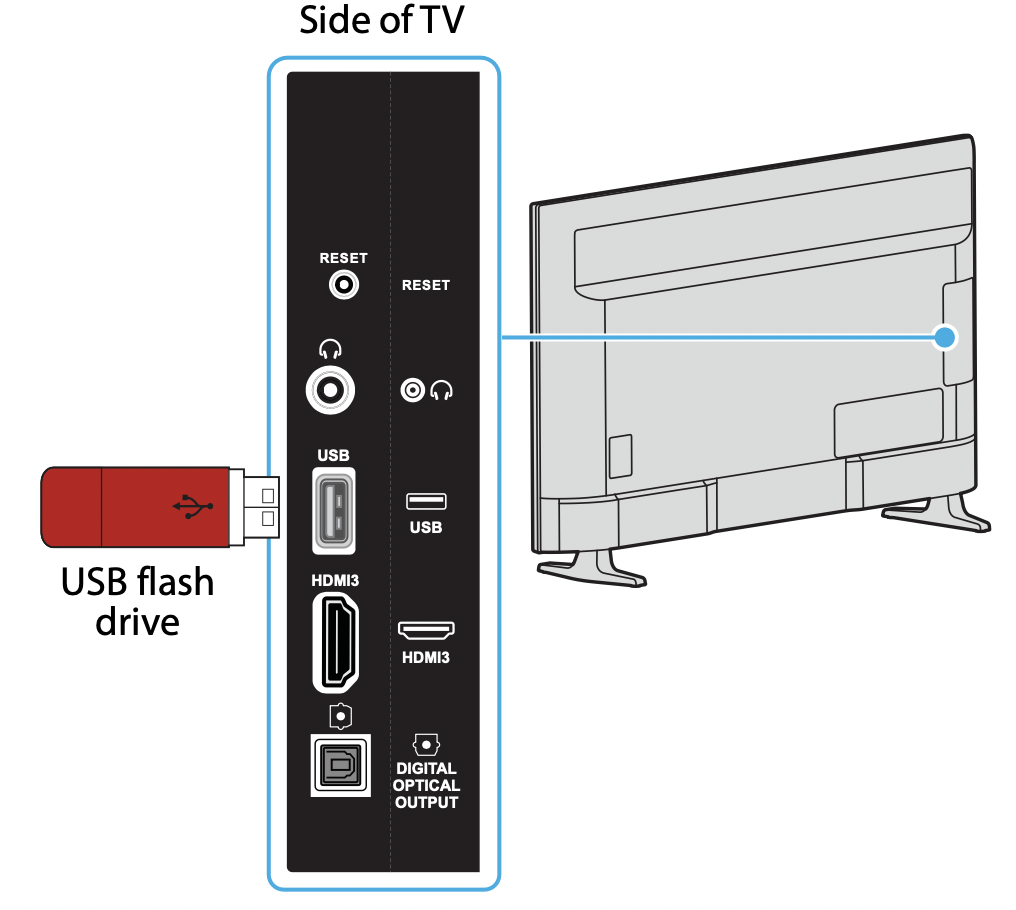
- Plug a USB flash drive into the USB port on the side of your TV.
Caution: Do not remove the USB flash drive or turn off your TV while using the USB flash drive. You may lose data or damage the USB flash drive. - Press
 or
or  to highlight the Roku Media Player or USB Media Player tile, then press OK.
to highlight the Roku Media Player or USB Media Player tile, then press OK.
Connecting headphones
When you connect headphones, your TV speakers are muted and sound only plays through the headphones.
Warning: Loud noise can damage your hearing. When using headphones, use the lowest volume setting on your headphones that still lets you hear the sound.

Connect the headphones to the  jack on the side of your TV.
jack on the side of your TV.
Note: You can also connect a home theater system, sound bar, or external speaker system to the  jack.
jack.
Connecting external speakers or a sound bar
When you connect external speakers or a sound bar, sound plays through your TV speakers and the external speakers or sound bar.
You can connect external speakers or a sound bar using:
- Digital audio using the DIGITAL OUTPUT (OPTICAL) jack
- Digital audio using the HDMI1(ARC) jack
- Analog audio using the AUDIO OUT jack
Digital audio using the DIGITAL OUTPUT (OPTICAL) jack
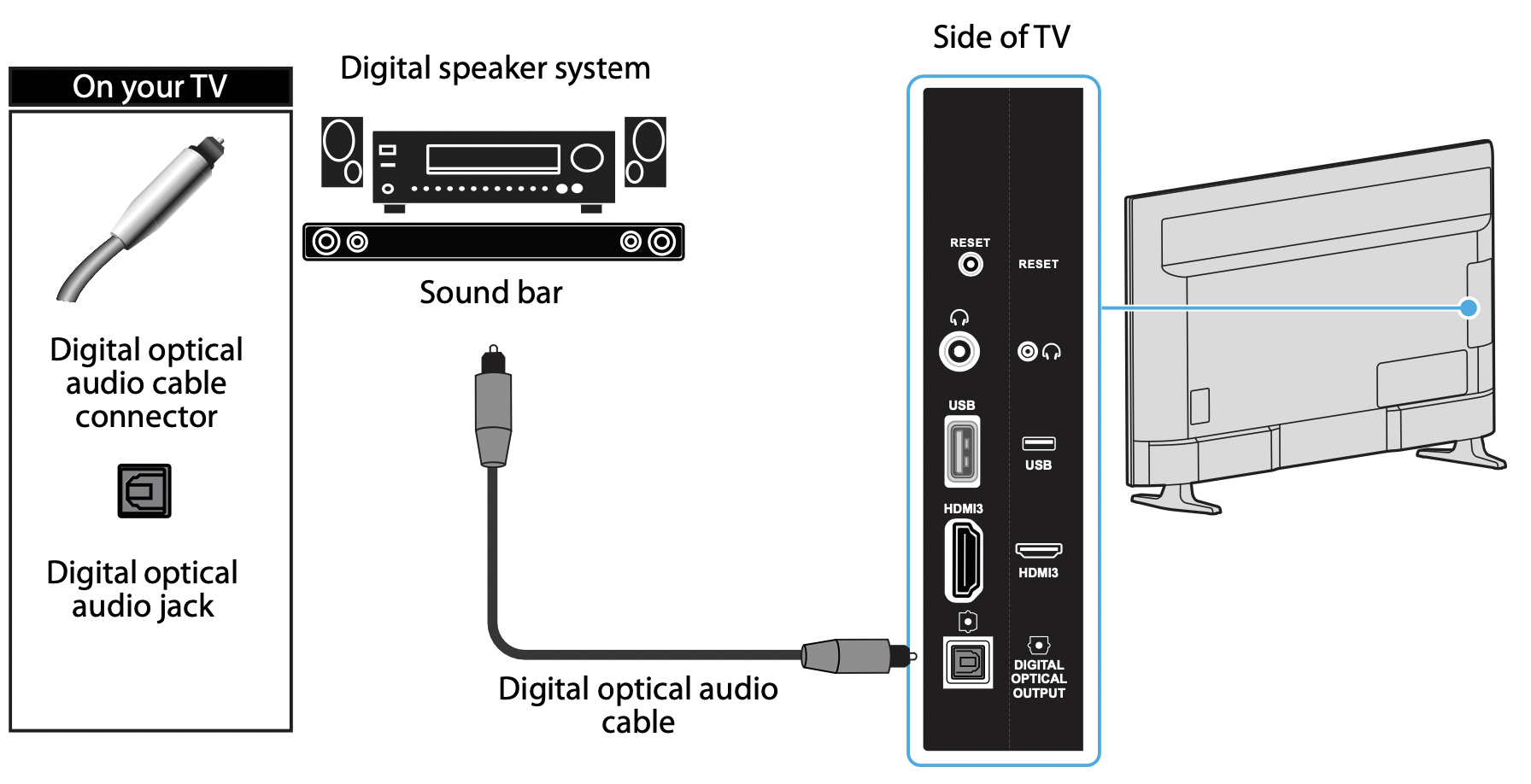
- Make sure that your TV’s power cord is unplugged and the digital speaker system or sound bar is turned off.
- Connect a digital optical audio cable (not provided) to the DIGITAL OUTPUT (OPTICAL) jack on the side of your TV and to the digital optical AUDIO IN jack on the digital speaker system or sound bar.
- Plug your TV’s power cord into a power outlet, then turn on your TV.
- Turn on the digital speaker system or sound bar, then set it to the correct source. For more information, see the documentation that came with the digital speaker system or sound bar.
- To turn off your TV speakers, on the Home menu, press
 or
or  to highlight Settings, then press OK. Highlight Audio, then press OK. Highlight TV speakers, then press OK. Press OK to remove the check from the TV speakers enabled check box.
to highlight Settings, then press OK. Highlight Audio, then press OK. Highlight TV speakers, then press OK. Press OK to remove the check from the TV speakers enabled check box.
Digital audio using the HDMI1(ARC) jack
Your TV can send sound to an ARC device, like an AV receiver, to create a home theater that uses two or more speakers. When you connect external speakers or a sound bar, sound plays through your TV speakers and the external speakers or sound bar.
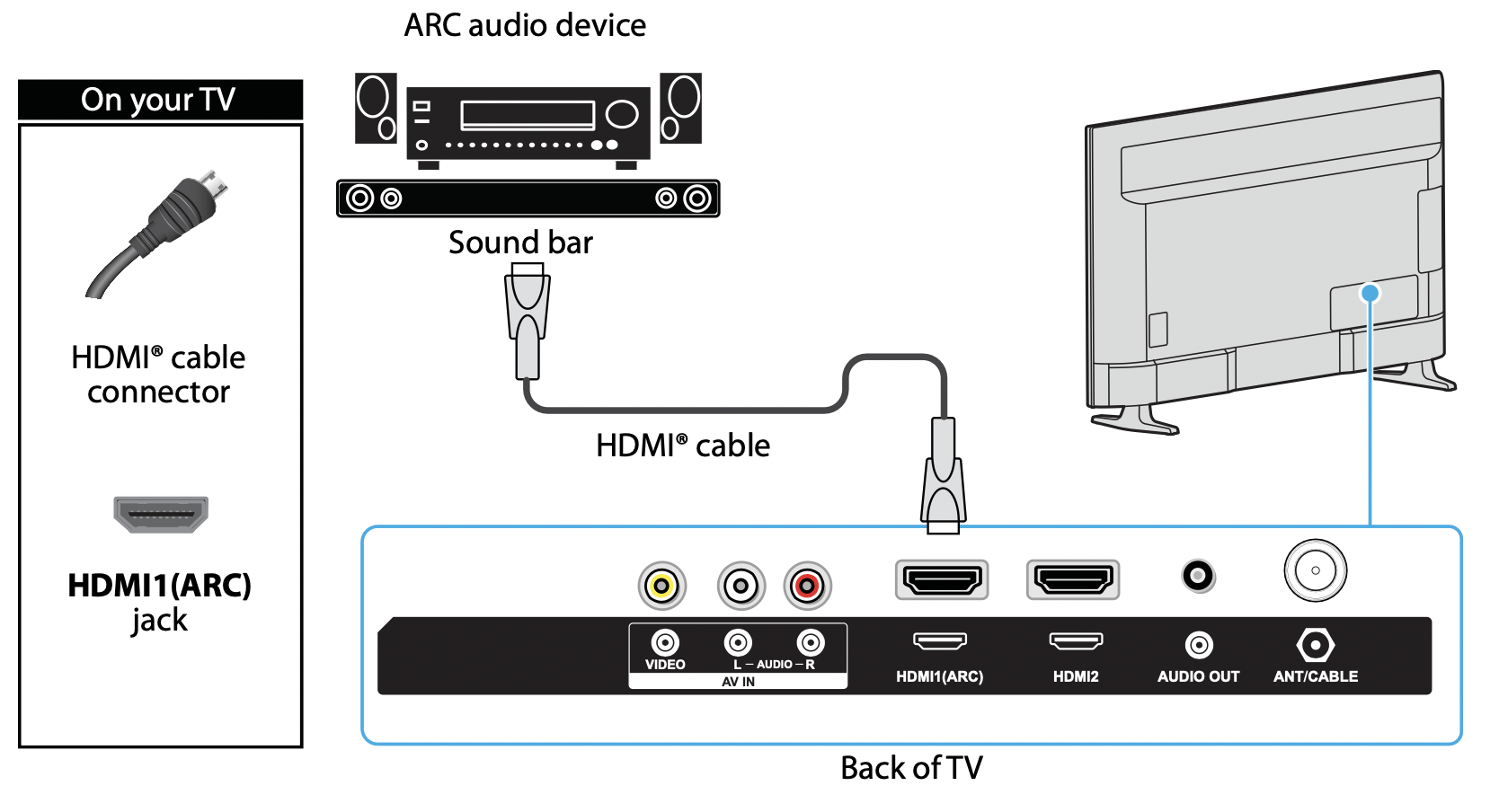
- Make sure that your TV’s power cord is unplugged and the digital speaker system or sound bar is turned off.
- Connect an HDMI® cable (not provided) to the HDMI1(ARC) jack on the back of your TV and to the HDMI IN jack on the digital speaker system or sound bar.
- Plug your TV’s power cord into a power outlet, then turn on your TV.
- Turn on the digital speaker system or sound bar, then set it to the correct source. For more information, see the documentation that came with the digital speaker system or sound bar.
- To turn off your TV speakers, on the Home menu, press
 or
or  to highlight Settings, then press OK. Highlight Audio, then press OK. Highlight TV speakers, then press OK. Press OK to remove the check from the TV speakers enabled check box.
to highlight Settings, then press OK. Highlight Audio, then press OK. Highlight TV speakers, then press OK. Press OK to remove the check from the TV speakers enabled check box. - To configure the HDMI1(ARC) jack to output sound to an ARC device, on the Home menu, press
 or
or  to highlight Settings, then press OK. Highlight System, then press OK. Highlight Control other devices (CEC), then press OK. Highlight HDMI ARC, then press OK to check the box.
to highlight Settings, then press OK. Highlight System, then press OK. Highlight Control other devices (CEC), then press OK. Highlight HDMI ARC, then press OK to check the box.
Analog audio using the AUDIO OUT jack
When you connect an analog speaker system or soundbar to the AUDIO OUT jack, sound plays through the TV speakers and the audio device.
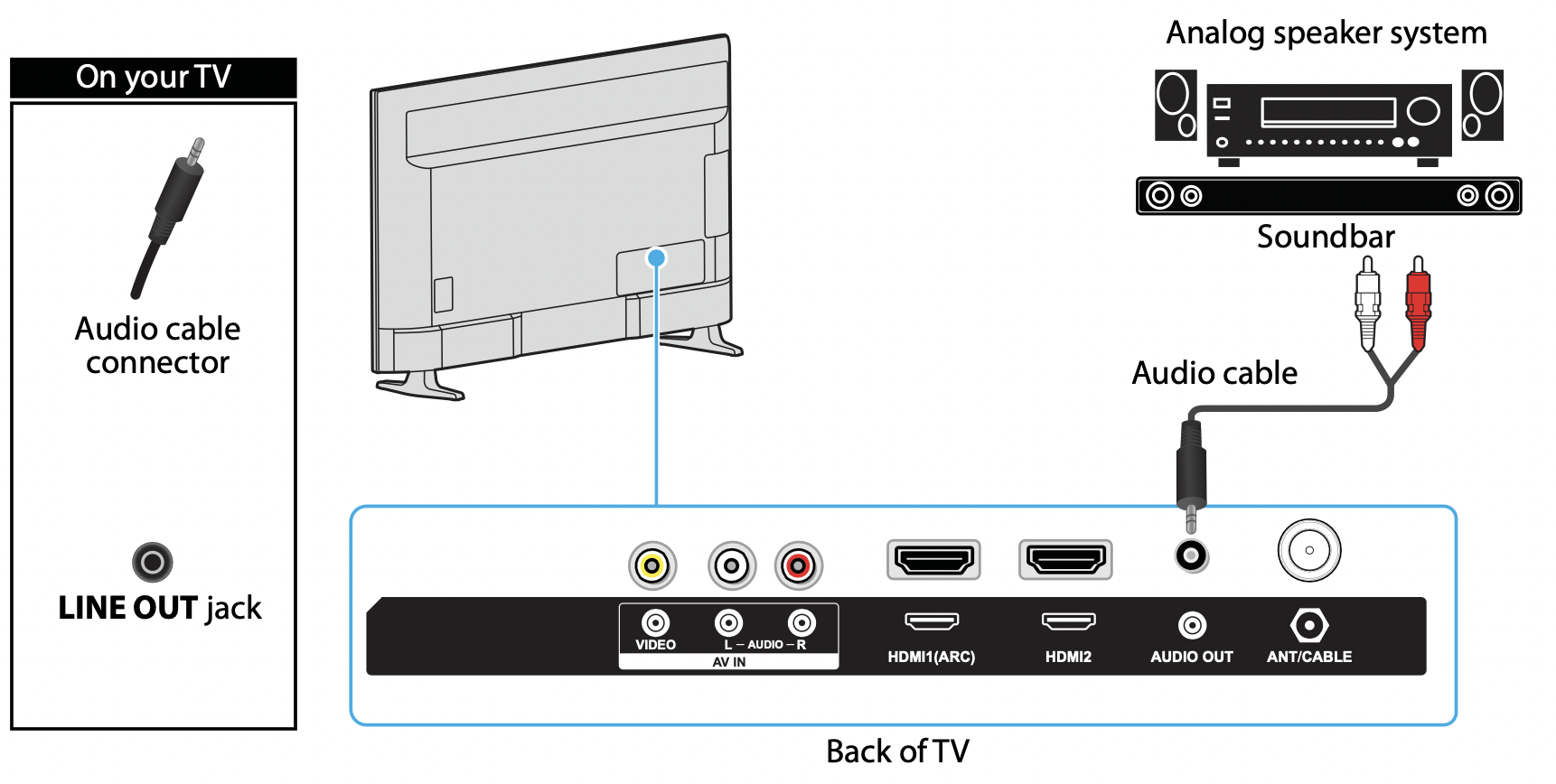
- Make sure that your TV’s power cord is unplugged and the analog speaker system or soundbar is turned off.
- Connect an audio cable (not provided) to the AUDIO OUT jack on the back of your TV and to the AUDIO IN jacks on the analog speaker system or soundbar.
- Plug your TV’s power cord into a power outlet, then turn on your TV.
- Turn on the analog speaker system or soundbar, then set it to the correct source. For more information, see the documentation that came with the analog speaker system or soundbar.
- To turn off your TV speakers, on the Home menu, press
 or
or  to highlight Settings, then press OK. Highlight Audio, then press OK. Highlight TV speakers, then press OK. Press OK to remove the check from the TV speakers enabled check box.
to highlight Settings, then press OK. Highlight Audio, then press OK. Highlight TV speakers, then press OK. Press OK to remove the check from the TV speakers enabled check box.
Note: Use the volume controls on the analog speaker system or soundbar to control the volume.
Connecting a home theater system with multiple devices
You can connect an AV receiver and your devices to create a home theater.
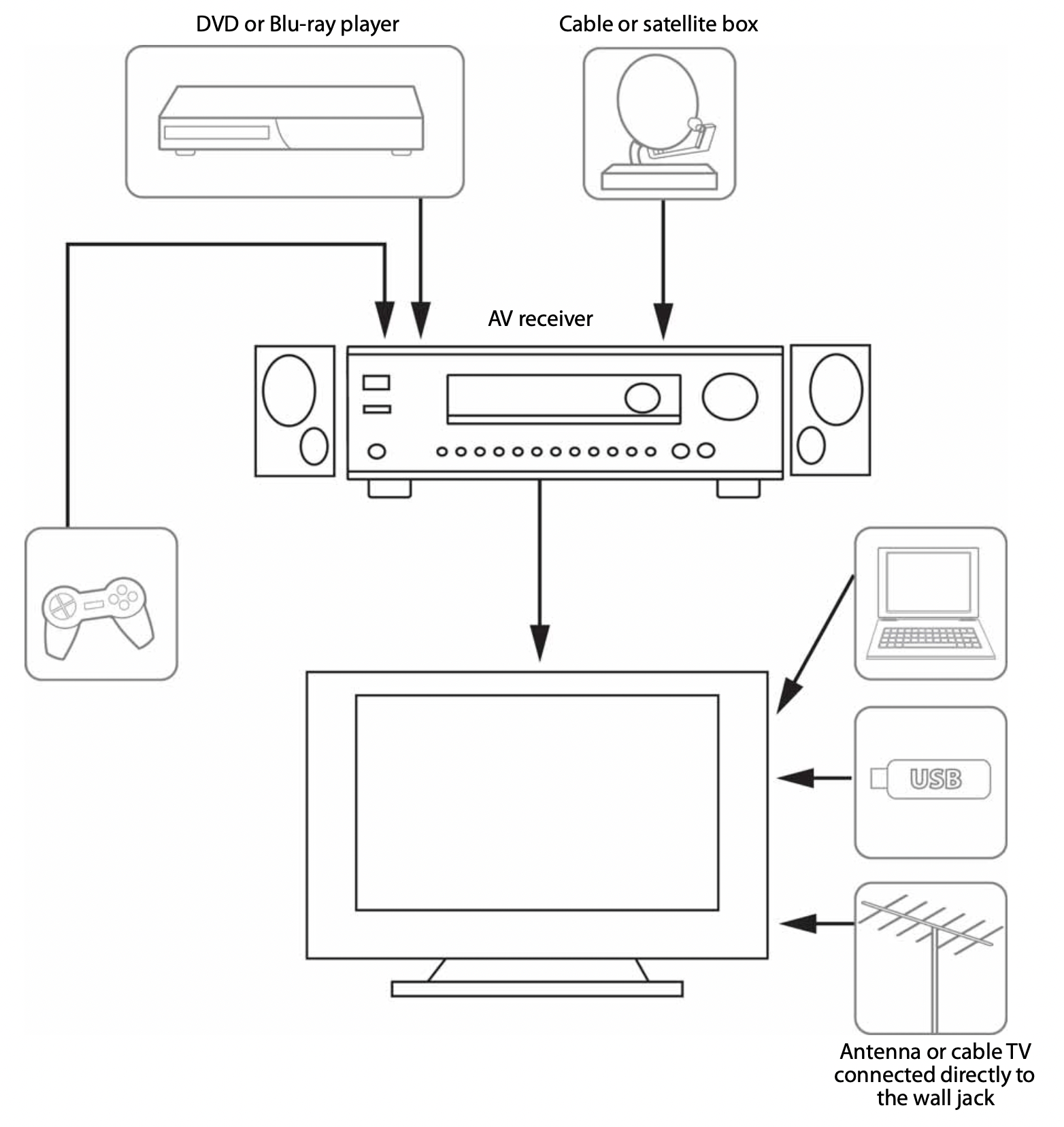
The connections you make depend on the video and audio jacks available on your devices. Refer to the documentation that came with your devices for connection information.
Just remember to use the best connection types available for the best picture and sound. For information about connection types, see What connection should I use? on page 17.
Connecting power
You should connect devices before you connect the power cord. When you are adding devices, make sure that the power cord is unplugged from the power outlet.
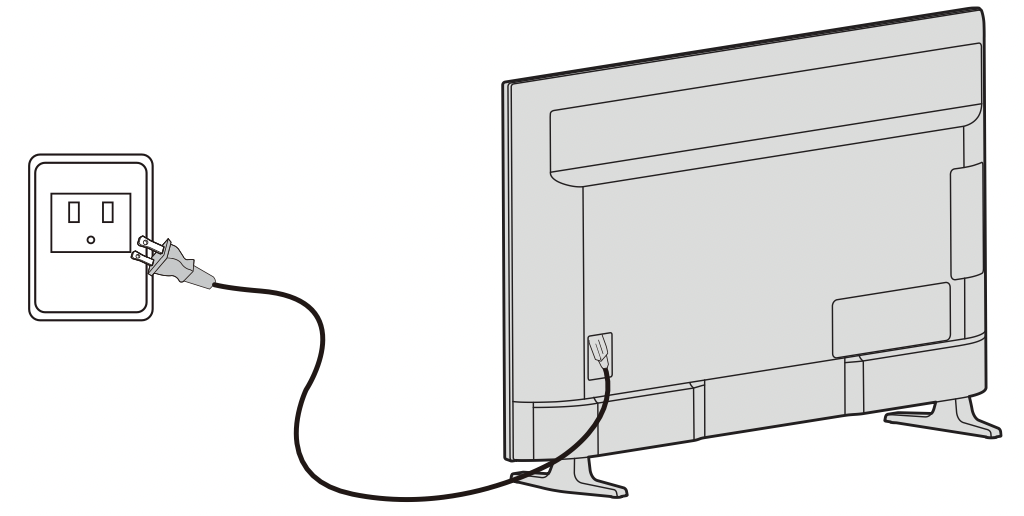
- Connect the power cord to the power connector on the back of your TV.
- Connect the other end of the cord to a power outlet.
Caution
- Your TV should only be operated from the power source indicated on the label.
- Always unplug the power cord from the power outlet when you will not be using your TV for an extended period of time.
Setting up your TV
When you turn on your TV for the first time, Guided Setup starts. During Guided Setup:
- Your TV automatically detects your wireless network, so have your network name and password handy and follow the easy on-screen instructions.
- You’ll be prompted to create your Roku account online at https://my.roku.com/link. Your TV generates a unique code that links your TV to your new account.
Note: Roku accounts are free, and while a valid credit card number is not required, providing your card information makes renting and purchasing entertainment a breeze.
- After you are connected to your account, your TV automatically updates with the latest software, and you can start streaming immediately.
Note: If you aren’t ready to connect your TV to a wireless network, you can still use it as a regular TV.
Maintaining
- Do not use your TV in areas that are too hot or too cold, because the cabinet may warp or the screen may malfunction. Your TV works best in temperatures that are comfortable to you.
- Storage temperatures are 5° to 113°F (-15°to 45°C).
- Working temperatures are 41° to 95°F (5°to 35°C).
- Do not place your TV in direct sunlight or near a heat source.
Cleaning your TV cabinet
Clean the cabinet with a soft, lint-free cloth. If the cabinet is especially dirty, moisten a soft, lint-free cloth in a weak detergent solution, squeeze the excess moisture from the cloth, then wipe the cabinet with the cloth. Use a clean cloth to dry the cabinet.
Cleaning your TV screen
Clean the screen with a soft, lint-free cloth.
Troubleshooting
Warning: Do not try to repair your TV yourself. Contact authorized service personnel.
Note: If the problem is not solved by using these troubleshooting instructions, turn off your TV, then turn it on again.
Video and audio
|
Symptom |
Possible cause |
Try this... |
|
Picture does not fill the screen or there are black bars around the picture |
The picture size may need to be adjusted |
|
|
I don’t see a picture when I select an input |
TV is not on |
|
|
Cables are not connected correctly |
|
|
|
Picture settings may be incorrect |
|
|
|
Incorrect input may be selected |
|
|
|
Input source not detected |
|
|
|
TV input may be bad |
|
|
|
TV channel does not appear |
Broadcast TV may be experiencing problems or may not be set up |
|
|
Dark, poor, or no picture (screen is lit), but sound is good |
Broadcast TV may be experiencing problems or may not be set up |
|
|
Cables may not be connected correctly |
|
|
|
Picture settings may be incorrect |
|
|
|
No color, dark picture, or color is not correct |
Picture settings may be incorrect |
|
|
Broadcast TV may be experiencing problems |
|
|
|
Cables are not connected correctly |
|
|
|
Only snow (noise) appears on the screen |
Broadcast TV may be experiencing problems or may not be set up |
|
|
Cables may not be connected correctly |
|
|
|
Picture quality is good on some channels and poor on others. Sound is good |
Broadcast signal may be weak |
|
|
Dotted linesor stripes appear on the screen |
Cables may not be connected correctly |
|
|
Broadcast signal may be weak |
|
|
|
Double images |
Broadcast signal may be weak |
|
|
The picture has a few bright or dark spots |
This is normal in LED TVs |
|
|
Good picture, but no sound |
Volume is down or muted |
|
|
Headphones may be connected |
|
|
|
TV speakers may be turned off |
|
|
|
You may need to change the audio mode |
|
|
|
Home theater system, soundbar, or external speaker system may not be turned on or may not be set up correctly |
|
|
|
Bad content, no audio |
|
|
|
Cables may not be connected correctly |
|
|
|
Poor picture |
Light in the viewing area maybe interfering |
|
|
A connected camera or camcorder may be interfering |
|
|
|
Audio noise |
Other devices maybe interfering |
|
|
After images appear |
|
Remote control
|
Symptom |
Possible cause |
Try this... |
|
My TV doesn’t turn on using the remote control |
No power to TV |
|
|
Line-of-sight obstructed |
|
|
|
Remote not responding |
|
|
|
TV frozen |
|
|
|
Trouble programming your existing universal remote control |
Remote control may not be programmed correctly |
|
|
Batteries may be dead |
|
General
|
Symptom |
Possible cause |
Try this... |
|
No power |
Power cord may not be connected correctly |
|
|
Other devices may be interfering |
|
|
|
My TV tuner does not pick up as many over-the-air channels as it should |
Antenna may not be placed optimally |
|
|
Broadcast TV may not be set up |
|
|
|
One or more channels do not display |
Channels may be blocked or hidden |
|
|
The wrong input maybe selected |
|
|
|
You may need to use the remote control that came with the cable or satellite box |
|
|
|
I lost my parental control PIN |
Need PIN recovery |
|
|
Some settings can not be accessed |
Not all settings are available for all devices or inputs |
|
|
TV cabinet creaks |
This is normal |
|
|
Control buttons do not work |
TV may be frozen |
|
|
TV keeps turning off |
Sleep timer may be turned on |
|
|
Some features are not available |
The wrong TV mode may be selected |
|
Roku
|
Symptom |
Possible cause |
Try this... |
|
How can I find out more about using my TV? |
|
|
|
I can’t turn my TV on with the Roku mobile app |
Your TV is “asleep” |
|
|
I can’t find my TV with the Roku mobile app |
TV and mobile app not on same wireless network |
|
|
TV not powered or working normally |
|
Network
|
Symptom |
Possible cause |
Try this... |
|
I can not connect to the Internet |
Network connection may not be setup |
|
|
Network name or password may have changed |
|
|
|
Streaming keeps pausing to load more data |
Wireless LAN not optimized |
|
|
Insufficient broadband speed |
|
CEC-compatible devices
|
Symptom |
Possible cause |
Try this... |
|
My TV is not displaying the video from the connected CEC device |
Cables may not be connected correctly |
|
|
Picture settings may be incorrect |
|
|
|
The selected input may be incorrect |
|
|
|
Connected device may not be a CEC device |
|
|
|
CEC control may not be setup correctly |
|
|
|
My TV is not playing the audio from the connected CEC device. |
Cables may not be connected correctly |
|
|
Volume may be too low or muted |
|
|
|
TV speakers may be turned off |
|
|
|
Connected device may not be a CEC device |
|
|
|
CEC control may not be setup correctly |
|
|
|
Connected audio device may not be set up correctly |
|
|
|
My TV’s remote control does not control the device |
Connected device may not be turned on |
|
|
Line-of-sight obstructed |
|
|
|
Connected device may not support some or all CEC features |
|
|
|
CEC control may not be setup correctly |
|
|
|
The device does not show up in the CEC device list |
Connected device may not be a CEC device |
|
|
Cables may not be connected correctly |
|
|
|
CEC control may not be set up correctly |
|
|
|
My device does not turn off when I turn off my TV |
Connected device may not be a CEC device |
|
|
Connected device may not support some or all CEC features |
|
|
|
CEC control may not be set up correctly |
|
|
|
My TV does not turn on when Iturn on my device |
Connected device may not be a CEC device |
|
|
Connected device may not support some or all CEC features |
|
|
|
CEC control may not be set up correctly |
|
